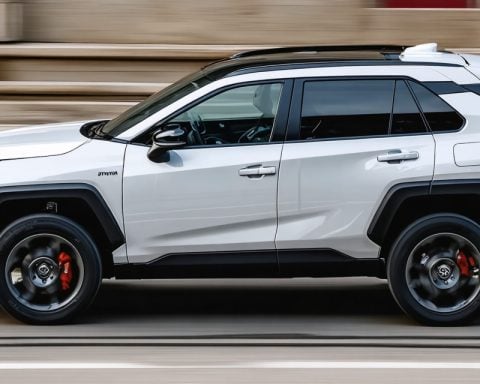Exciting Shifts in Australia’s Auto Market
2024 witnessed an unprecedented boom in new-car sales across Australia, accompanied by unexpected trends and developments. Despite soaring sales figures, significant changes were brewing beneath the surface.
The spotlight was firmly on the Suzuki Jimny, which saw an astonishing 93.9% increase in sales, reaching nearly 10,000 units sold. The introduction of the larger five-door Jimny XL model in late 2023 likely contributed to its newfound popularity, allowing more Australians to enjoy its off-road capabilities.
Conversely, RAM faced a downturn, with a significant 43.6% drop in overall sales. Although the RAM 1500 remained the leading full-size pick-up, the decline signals potential shifts in consumer preferences.
Toyota, although setting sales records with over 241,296 vehicles sold, saw its venerable Prado suffer a substantial dip in sales. This decline is linked to its aging design and an expected new model arriving soon.
Meanwhile, GWM made strides by entering the top ten best-sellers with its SUVs, benefiting from the growing acceptance of Chinese brands in a competitive market. Additionally, BYD and Chery recorded staggering growth rates, indicating a dynamic landscape ahead.
As the automotive industry braces for another thrilling year in 2025, everyone is keenly watching how these new players will influence future sales.
Australia’s Auto Market: Trends, Innovations, and Future Predictions
The Australian automotive market has undergone significant transformations in 2024, marked by record-breaking new car sales and emerging trends that could reshape the landscape of vehicle ownership. As we assess this dynamic market, several key features, innovations, and predictions emerge.
Key Trends and Insights
1. Shifting Consumer Preferences:
The substantial rise in the popularity of the Suzuki Jimny indicates a growing consumer preference for compact and versatile vehicles, particularly those with off-road capabilities. This shift highlights an increasing interest in adventure-oriented small SUVs, appealing to a demographic keen on exploring Australia’s rugged terrains.
2. Emergence of Chinese Manufacturers:
Brands like GWM, BYD, and Chery are making significant headway in the Australian market, accounting for a notable increase in sales. The acceptance of these brands suggests a shift in consumer perception, as buyers are increasingly willing to consider vehicles from manufacturers traditionally viewed as newcomers.
3. Sustainability Trends:
The push for electric vehicles (EVs) continues to gain momentum, with companies like BYD leading the charge. As Australians increasingly prioritize sustainability, the growth of EV sales is expected to accelerate, reflecting broader global trends toward greener transportation.
Pros and Cons of the Changing Market
Pros:
– Diverse Options: The influx of new brands and models provides consumers with a wider range of choices tailored to various preferences and budgets.
– Price Competitiveness: Increased competition among manufacturers can lead to more competitive pricing, benefitting consumers.
Cons:
– Market Saturation: With numerous brands entering the market, there may be challenges related to customer service and vehicle support.
– Quality Concerns: As new manufacturers gain traction, questions regarding the long-term reliability and quality of their vehicles could pose challenges for consumer trust.
Comparisons to Traditional Brands
While Toyota remains a dominant player with impressive sales, the decline in sales for the Prado indicates that legacy brands must quickly adapt to keep pace with market changes. Unlike the forecasted growth for SUVs from newer brands, traditional models may struggle to maintain their relevance without timely updates and innovations.
Pricing Trends
The fluctuations in vehicle pricing are influenced by ongoing supply chain issues and the rising cost of raw materials. Consumers may see a range of pricing strategies as brands look to attract buyers amidst growing competition. As electric vehicles gain a more substantial market share, there may also be a shift toward mid-range pricing to accommodate budget-conscious consumers.
Limitations and Challenges
1. Supply Chain Disruptions: Ongoing global supply chain challenges remain a limitation for many manufacturers, affecting vehicle availability and potentially delaying the introduction of new models.
2. Consumer Education: As new technologies emerge, consumer education on the benefits and functionalities of EVs and other innovative models is essential for driving adoption.
Future Predictions
Looking ahead to 2025 and beyond:
– Continued Growth of EVs: Electric vehicles are predicted to see increased market penetration, supported by government incentives and growing infrastructure.
– Technological Innovations: Advances in vehicle technology, including autonomous driving features and connectivity, are expected to become standard in new models, enhancing consumer appeal.
– Increased Market Segmentation: The growth of niche markets, such as adventure vehicles and urban electric models, will likely redefine how brands approach their product offerings.
Overall, the Australian automotive market is poised for an exhilarating future. As new players emerge and consumer behaviors evolve, the landscape will continue to shift, creating opportunities for innovation and change. The automotive industry in Australia is no longer just about vehicles; it’s about lifestyle preferences, sustainability, and embracing new technologies.
For further updates on the automotive sector, visit Auto Australia.












